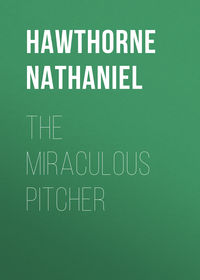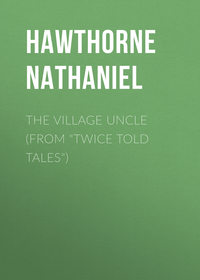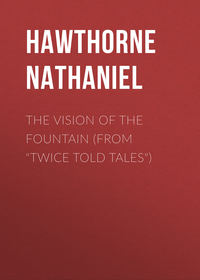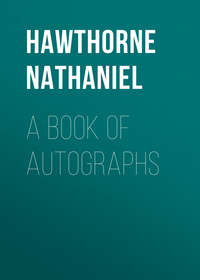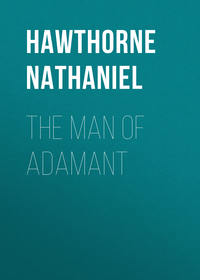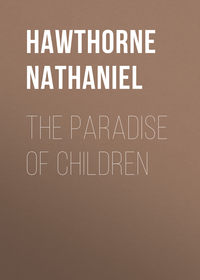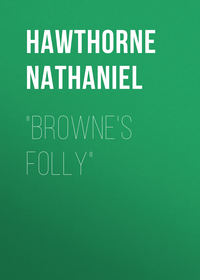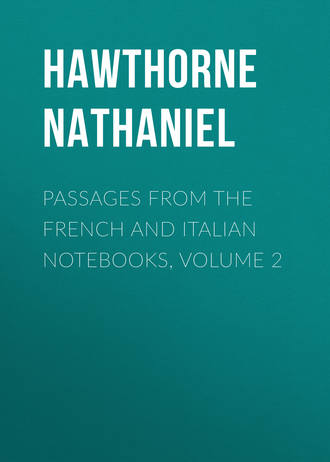 полная версия
полная версияPassages from the French and Italian Notebooks, Volume 2
It was useless to try to see the pictures. All the artists engaged in copying laid aside their brushes; and we looked out into the square before the palace, where a mighty wind sprang up, and quickly raised a prodigious cloud of dust. It hid the opposite side of the street, and was carried, in a great dusky whirl, higher than the roofs of the houses, higher than the top of the Pitti Palace itself. The thunder muttered and grumbled, the lightning now and then flashed, and a few rain-drops pattered against the windows; but, for a long time, the shower held off. At last it came down in a stream, and lightened the air to such a degree that we could see some of the pictures, especially those of Rubens, and the illuminated parts of Salvator Rosa's, and, best of all, Titian's "Magdalen," the one with golden hair clustering round her naked body. The golden hair, indeed, seemed to throw out a glory of its own. This Magdalen is very coarse and sensual, with only an impudent assumption of penitence and religious sentiment, scarcely so deep as the eyelids; but it is a splendid picture, nevertheless, with those naked, lifelike arms, and the hands that press the rich locks about her, and so carefully permit those voluptuous breasts to be seen. She a penitent! She would shake off all pretence to it as easily as she would shake aside that clustering hair… Titian must have been a very good-for-nothing old man.
I looked again at Michael Angelo's Fates to-day; but cannot satisfactorily make out what he meant by them. One of them – she who holds the distaff – has her mouth open, as if uttering a cry, and might be fancied to look somewhat irate. The second, who holds the thread, has a pensive air, but is still, I think, pitiless at heart. The third sister looks closely and coldly into the eyes of the second, meanwhile cutting the thread with a pair of shears. Michael Angelo, if I may presume to say so, wished to vary the expression of these three sisters, and give each a different one, but did not see precisely how, inasmuch as all the fatal Three are united, heart and soul, in one purpose. It is a very impressive group. But, as regards the interpretation of this, or of any other profound picture, there are likely to be as many interpretations as there are spectators. It is very curious to read criticisms upon pictures, and upon the same face in a picture, and by men of taste and feeling, and to find what different conclusions they arrive at. Each man interprets the hieroglyphic in his own way; and the painter, perhaps, had a meaning which none of them have reached; or possibly he put forth a riddle, without himself knowing the solution. There is such a necessity, at all events, of helping the painter out with the spectator's own resources of feeling and imagination, that you can never be sure how much of the picture you have yourself made. There is no doubt that the public is, to a certain extent, right and sure of its ground, when it declares, through a series of ages, that a certain picture is a great work. It is so; a great symbol, proceeding out of a great mind; but if it means one thing, it seems to mean a thousand, and, often, opposite things.
June 27th. – I have had a heavy cold and fever almost throughout the past week, and have thereby lost the great Florentine festivity, the Feast of St. John, which took place on Thursday last, with the fireworks and illuminations the evening before, and the races and court ceremonies on the day itself. However, unless it were more characteristic and peculiar than the Carnival, I have not missed anything very valuable.
Mr. Powers called to see me one evening, and poured out, as usual, a stream of talk, both racy and oracular in its character. Speaking of human eyes, he observed that they did not depend for their expression upon color, nor upon any light of the soul beaming through them, nor any glow of the eyeball, nor upon anything but the form and action of the surrounding muscles. He illustrates it by saying, that if the eye of a wolf, or of whatever fiercest animal, could be placed in another setting, it would be found capable of the utmost gentleness of expression. "You yourself," said he, "have a very bright and sharp look sometimes; but it is not in the eye itself." His own eyes, as I could have sworn, were glowing all the time he spoke; and, remembering how many times I have seemed to see eyes glow, and blaze, and flash, and sparkle, and melt, and soften; and how all poetry is illuminated with the light of ladies' eyes; and how many people have been smitten by the lightning of an eye, whether in love or anger, it was difficult to allow that all this subtlest and keenest fire is illusive, not even phosphorescent, and that any other jelly in the same socket would serve as well as the brightest eye. Nevertheless, he must be right; of course he must, and I am rather ashamed ever to have thought otherwise. Where should the light come from? Has a man a flame inside of his head? Does his spirit manifest itself in the semblance of flame? The moment we think of it, the absurdity becomes evident. I am not quite sure, however, that the outer surface of the eye may not reflect more light in some states of feeling than in others; the state of the health, certainly, has an influence of this kind.
I asked Powers what he thought of Michael Angelo's statue of Lorenzo de' Medici. He allowed that its effect was very grand and mysterious; but added that it owed this to a trick, – the effect being produced by the arrangement of the hood, as he called it, or helmet, which throws the upper part of the face into shadow. The niche in which it sits has, I suppose, its part to perform in throwing a still deeper shadow. It is very possible that Michael Angelo may have calculated upon this effect of sombre shadow, and legitimately, I think; but it really is not worthy of Mr. Powers to say that the whole effect of this mighty statue depends, not on the positive efforts of Michael Angelo's chisel, but on the absence of light in a space of a few inches. He wrought the whole statue in harmony with that small part of it which he leaves to the spectator's imagination, and if he had erred at any point, the miracle would have been a failure; so that, working in marble, he has positively reached a degree of excellence above the capability of marble, sculpturing his highest touches upon air and duskiness.
Mr. Powers gave some amusing anecdotes of his early life, when he was a clerk in a store in Cincinnati. There was a museum opposite, the proprietor of which had a peculiar physiognomy that struck Powers, insomuch that he felt impelled to make continual caricatures of it. He used to draw them upon the door of the museum, and became so familiar with the face, that he could draw them in the dark; so that, every morning, here was this absurd profile of himself, greeting the museum-man when he came to open his establishment. Often, too, it would reappear within an hour after it was rubbed out. The man was infinitely annoyed, and made all possible efforts to discover the unknown artist, but in vain; and finally concluded, I suppose, that the likeness broke out upon the door of its own accord, like the nettle-rash. Some years afterwards, the proprietor of the museum engaged Powers himself as an assistant; and one day Powers asked him if he remembered this mysterious profile. "Yes," said he, "did you know who drew them?" Powers took a piece of chalk, and touched off the very profile again, before the man's eyes. "Ah," said he, "if I had known it at the time, I would have broken every bone in your body!"
Before he began to work in marble, Powers had greater practice and success in making wax figures, and he produced a work of this kind called "The Infernal Regions," which he seemed to imply had been very famous. He said he once wrought a face in wax which was life itself, having made the eyes on purpose for it, and put in every hair in the eyebrows individually, and finished the whole with similar minuteness; so that, within the distance of a foot or two, it was impossible to tell that the face did not live.
I have hardly ever before felt an impulse to write down a man's conversation as I do that of Mr. Powers. The chief reason is, probably, that it is so possible to do it, his ideas being square, solid, and tangible, and therefore readily grasped and retained. He is a very instructive man, and sweeps one's empty and dead notions out of the way with exceeding vigor; but when you have his ultimate thought and perception, you feel inclined to think and see a little further for yourself. He sees too clearly what is within his range to be aware of any region of mystery beyond. Probably, however, this latter remark does him injustice. I like the man, and am always glad to encounter the mill-stream of his talk… Yesterday he met me in the street (dressed in his linen blouse and slippers, with a little bit of a sculptor's cap on the side of his head), and gave utterance to a theory of colds, and a dissertation on the bad effects of draughts, whether of cold air or hot, and the dangers of transfusing blood from the veins of one living subject to those of another. On the last topic, he remarked that, if a single particle of air found its way into the veins, along with the transfused blood, it caused convulsions and inevitable death; otherwise the process might be of excellent effect.
Last evening, we went to pass the evening with Miss Blagden, who inhabits a villa at Bellosguardo, about a mile outside of the walls. The situation is very lofty, and there are good views from every window of the house, and an especially fine one of Florence and the hills beyond, from the balcony of the drawing-room. By and by came Mr. Browning, Mr. Trollope, Mr. Boott and his young daughter, and two or three other gentlemen..
Browning was very genial and full of life, as usual, but his conversation has the effervescent aroma which you cannot catch, even if you get the very words that seem to be imbued with it. He spoke most rapturously of a portrait of Mrs. Browning, which an Italian artist is painting for the wife of an American gentleman, as a present from her husband. The success was already perfect, although there had been only two sittings as yet, and both on the same day; and in this relation, Mr. Browning remarked that P – , the American artist, had had no less than seventy-three sittings of him for a portrait. In the result, every hair and speck of him was represented; yet, as I inferred from what he did not say, this accumulation of minute truths did not, after all, amount to the true whole.
I do not remember much else that Browning said, except a playful abuse of a little King Charles spaniel, named Frolic, Miss Blagden's lap-dog, whose venerable age (he is eleven years old) ought to have pleaded in his behalf. Browning's nonsense is of very genuine and excellent quality, the true babble and effervescence of a bright and powerful mind; and he lets it play among his friends with the faith and simplicity of a child. He must be an amiable man. I should like him much, and should make him like me, if opportunities were favorable.
I conversed principally with Mr. Trollope, the son, I believe, of the Mrs. Trollope to whom America owes more for her shrewd criticisms than we are ever likely to repay. Mr. Trollope is a very sensible and cultivated man, and, I suspect, an author: at least, there is a literary man of repute of this name, though I have never read his works. He has resided in Italy eighteen years. It seems a pity to do this. It needs the native air to give life a reality; a truth which I do not fail to take home regretfully to myself, though without feeling much inclination to go back to the realities of my own.
We had a pleasant cup of tea, and took a moonlight view of Florence from the balcony..
June 28th. – Yesterday afternoon, J – and I went to a horse-race, which took place in the Corso and contiguous line of streets, in further celebration of the Feast of St. John. A crowd of people was already collected, all along the line of the proposed race, as early as six o'clock; and there were a great many carriages driving amid the throng, open barouches mostly, in which the beauty and gentility of Florence were freely displayed. It was a repetition of the scene in the Corso at Rome, at Carnival time, without the masks, the fun, and the confetti. The Grand Duke and Duchess and the Court likewise made their appearance in as many as seven or eight coaches-and-six, each with a coachman, three footmen, and a postilion in the royal livery, and attended by a troop of horsemen in scarlet coats and cocked hats. I did not particularly notice the Grand Duke himself; but, in the carriage behind him, there sat only a lady, who favored the people along the street with a constant succession of bows, repeated at such short intervals, and so quickly, as to be little more than nods; therefore not particularly graceful or majestic. Having the good fortune, to be favored with one of these nods, I lifted my hat in response, and may therefore claim a bowing acquaintance with the Grand Duchess. She is a Bourbon of the Naples family, and was a pale, handsome woman, of princely aspect enough. The crowd evinced no enthusiasm, nor the slightest feeling of any kind, in acknowledgment of the presence of their rulers; and, indeed, I think I never saw a crowd so well behaved; that is, with so few salient points, so little ebullition, so absolutely tame, as the Florentine one. After all, and much contrary to my expectations, an American crowd has incomparably more life than any other; and, meeting on any casual occasion, it will talk, laugh, roar, and be diversified with a thousand characteristic incidents and gleams and shadows, that you see nothing of here. The people seems to have no part even in its own gatherings. It comes together merely as a mass of spectators, and must not so much as amuse itself by any activity of mind.
The race, which was the attraction that drew us all together, turned out a very pitiful affair. When we had waited till nearly dusk, the street being thronged quite across, insomuch that it seemed impossible that it should be cleared as a race-course, there came suddenly from every throat a quick, sharp exclamation, combining into a general shout. Immediately the crowd pressed back on each side of the street; a moment afterwards, there was a rapid pattering of hoofs over the earth with which the pavement was strewn, and I saw the head and back of a horse rushing past. A few seconds more, and another horse followed; and at another little interval, a third. This was all that we had waited for; all that I saw, or anybody else, except those who stood on the utmost verge of the course, at the risk of being trampled down and killed. Two men were killed in this way on Thursday, and certainly human life was never spent for a poorer object. The spectators at the windows, to be sure, having the horses in sight for a longer time, might get a little more enjoyment out of the affair. By the by, the most picturesque aspect of the scene was the life given to it by the many faces, some of them fair ones, that looked out from window and balcony, all along the curving line of lofty palaces and edifices, between which the race-course lay; and from nearly every window, and over every balcony, was flung a silken texture, or cloth of brilliant line, or piece of tapestry or carpet, or whatever adornment of the kind could be had, so as to dress up the street in gala attire. But, the Feast of St. John, like the Carnival, is but a meagre semblance of festivity, kept alive factitiously, and dying a lingering death of centuries. It takes the exuberant mind and heart of a people to keep its holidays alive.
I do not know whether there be any populace in Florence, but I saw none that I recognized as such, on this occasion. All the people were respectably dressed and perfectly well behaved; and soldiers and priests were scattered abundantly among the throng. On my way home, I saw the Teatro Goldoni, which is in our own street, lighted up for a representation this Sunday evening. It shocked my New England prejudices a little.
Thus forenoon, my wife and I went to the Church of Santa Croce, the great monumental deposit of Florentine worthies. The piazza before it is a wide, gravelled square, where the liberty of Florence, if it really ever had any genuine liberty, came into existence some hundreds of years ago, by the people's taking its own rights into its hands, and putting its own immediate will in execution. The piazza has not much appearance of antiquity, except that the facade of one of the houses is quite covered with ancient frescos, a good deal faded and obliterated, yet with traces enough of old glory to show that the colors must have been well laid on.
The front of the church, the foundation of which was laid six centuries ago, is still waiting for its casing of marbles, and I suppose will wait forever, though a carpenter's staging is now erected before it, as if with the purpose of doing something.
The interior is spacious, the length of the church being between four and five hundred feet. There is a nave, roofed with wooden cross-beams, lighted by a clere-story and supported on each side by seven great pointed arches, which rest upon octagonal pillars. The octagon seems to be a favorite shape in Florence. These pillars were clad in yellow and scarlet damask, in honor of the Feast of St. John. The aisles, on each side of the nave, are lighted with high and somewhat narrow windows of painted glass, the effect of which, however, is much diminished by the flood of common daylight that comes in through the windows of the clere-story. It is like admitting too much of the light of reason and worldly intelligence into the mind, instead of illuminating it wholly through a religious medium. The many-hued saints and angels lose their mysterious effulgence, when we get white light enough, and find we see all the better without their help.
The main pavement of the church is brickwork; but it is inlaid with many sepulchral slabs of marble, on some of which knightly or priestly figures are sculptured in bas-relief. In both of the side aisles there are saintly shrines, alternating with mural monuments, some of which record names as illustrious as any in the world. As you enter, the first monument, on your right is that of Michael Angelo, occupying the ancient burial-site of his family. The general design is a heavy sarcophagus of colored marble, with the figures of Sculpture, Painting, and Architecture as mourners, and Michael Angelo's bust above, the whole assuming a pyramidal form. You pass a shrine, within its framework of marble pillars and a pediment, and come next to Dante's monument, a modern work, with likewise its sarcophagus, and some huge, cold images weeping and sprawling over it, and an unimpressive statue of Dante sitting above.
Another shrine intervenes, and next you see the tomb of Alfieri, erected to his memory by the Countess of Albany, who pays, out of a woman's love, the honor which his country owed him. Her own monument is in one of the chapels of the transept.
Passing the next shrine you see the tomb of Macchiavelli, which, I think, was constructed not many years after his death. The rest of the monuments, on this side of the church, commemorate people of less than world-wide fame; and though the opposite side has likewise a monument alternating with each shrine, I remember only the names of Raphael Morghen and of Galileo. The tomb of the latter is over against that of Michael Angelo, being the first large tomb on the left-hand wall as you enter the church. It has the usual heavy sarcophagus, surmounted by a bust of Galileo, in the habit of his time, and is, of course, duly provided with mourners in the shape of Science or Astronomy, or some such cold-hearted people. I wish every sculptor might be at once imprisoned for life who shall hereafter chisel an allegoric figure; and as for those who have sculptured them heretofore, let them be kept in purgatory till the marble shall have crumbled away. It is especially absurd to assign to this frozen sisterhood of the allegoric family the office of weeping for the dead, inasmuch as they have incomparably less feeling than a lump of ice, which might contrive to shed a tear if the sun shone on it. But they seem to let themselves out, like the hired mourners of an English funeral, for the very reason that, having no interest in the dead person, nor any affections or emotions whatever, it costs them no wear and tear of heart.
All round both transepts of the church there is a series of chapels, into most of which we went, and generally found an inscrutably dark picture over the altar, and often a marble bust or two, or perhaps a mediaeval statue of a saint or a modern monumental bas-relief in marble, as white as new-fallen snow. A chapel of the Bonapartes is here, containing memorials of two female members of the family. In several chapels, moreover, there were some of those distressing frescos, by Giotto, Cimabue, or their compeers, which, whenever I see them, – poor, faded relics, looking as if the Devil had been rubbing and scrubbing them for centuries, in spite against the saints, – my heart sinks and my stomach sickens. There is no other despondency like this; it is a new shade of human misery, akin to the physical disease that comes from dryrot in a wall. These frescos are to a church what dreary, old remembrances are to a mind; the drearier because they were once bright: Hope fading into Disappointment, Joy into Grief, and festal splendor passing into funereal duskiness, and saddening you all the more by the grim identity that you find to exist between gay things and sorrowful ones. Only wait long enough, and they turn out to be the very same.
All the time we were in the church some great religious ceremony had been going forward; the organ playing and the white-robed priests bowing, gesticulating, and making Latin prayers at the high altar, where at least a hundred wax tapers were burning in constellations. Everybody knelt, except ourselves, yet seemed not to be troubled by the echoes of our passing footsteps, nor to require that we should pray along with them. They consider us already lost irrevocably, no doubt, and therefore right enough in taking no heed of their devotions; not but what we took so much heed, however, as to give the smallest possible disturbance. By and by we sat down in the nave of the church till the ceremony should be concluded; and then my wife left me to go in quest of yet another chapel, where either Cimabue or Giotto, or both, have left some of their now ghastly decorations. While she was gone I threw my eyes about the church, and came to the conclusion that, in spite of its antiquity, its size, its architecture, its painted windows, its tombs of great men, and all the reverence and interest that broods over them, it is not an impressive edifice. Any little Norman church in England would impress me as much, and more. There is something, I do not know what, but it is in the region of the heart, rather than in the intellect, that Italian architecture, of whatever age or style, never seems to reach.
Leaving the Santa Croce, we went next in quest of the Riccardi Palace. On our way, in the rear of the Grand Ducal Piazza, we passed by the Bargello, formerly the palace of the Podesta of Florence, and now converted into a prison. It is an immense square edifice of dark stone, with a tall, lank tower rising high above it at one corner. Two stone lions, symbols of the city, lash their tails and glare at the passers-by; and all over the front of the building windows are scattered irregularly, and grated with rusty iron bars; also there are many square holes, which probably admit a little light and a breath or two of air into prisoners' cells. It is a very ugly edifice, but looks antique, and as if a vast deal of history might have been transacted within it, or have beaten, like fierce blasts, against its dark, massive walls, since the thirteenth century. When I first saw the city it struck me that there were few marks of antiquity in Florence; but I am now inclined to think otherwise, although the bright Italian atmosphere, and the general squareness and monotony of the Italian architecture, have their effect in apparently modernizing everything. But everywhere we see the ponderous Tuscan basements that never can decay, and which will look, five hundred years hence, as they look now; and one often passes beneath an abbreviated remnant of what was once a lofty tower, perhaps three hundred feet high, such as used to be numerous in Florence when each noble of the city had his own warfare to wage; and there are patches of sculpture that look old on houses, the modern stucco of which causes them to look almost new. Here and there an unmistakable antiquity stands in its own impressive shadow; the Church of Or San Michele, for instance, once a market, but which grew to be a church by some inherent fitness and inevitable consecration. It has not the least the aspect of a church, being high and square, like a mediaeval palace; but deep and high niches are let into its walls, within which stand great statues of saints, masterpieces of Donatello, and other sculptors of that age, before sculpture began to be congealed by the influence of Greek art.




